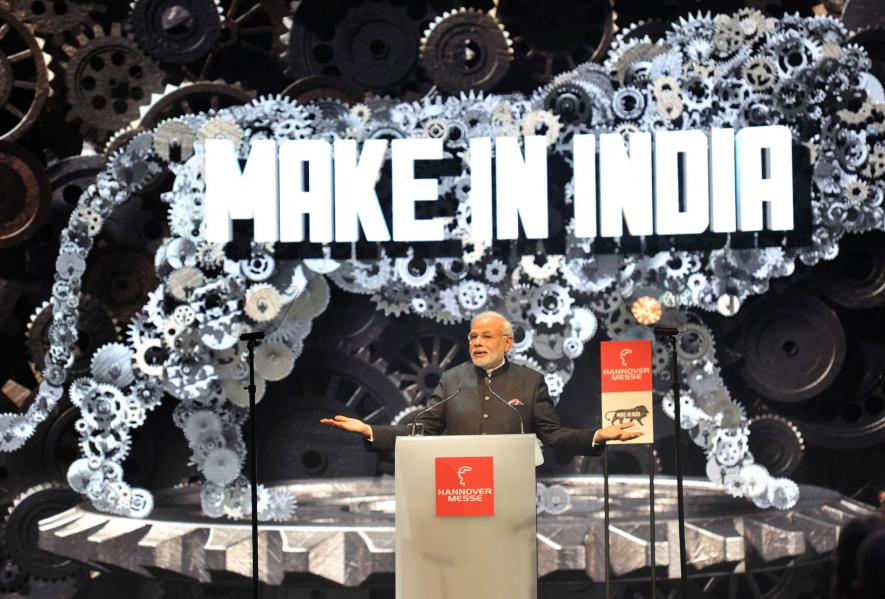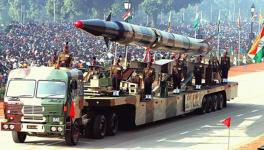The Fake Nationalism of Make in India

Fake nationalism of the Hindutva variety is not limited to only the national movement, where the RSS was conspicuous by its absence. It is also manifested in Modi's Make in India, which is an offer to global capital to exploit India's cheap labour, along with various tax breaks and subsidised land. This is in contrast to how self reliance and development was seen in the national movement. It saw developing knowledge as integral to the process of developing the country and its people. This was the difference between Made in India and its indigenisation vision, as opposed to inviting global capital under Modi to Make in India.
The difference between the vision of the national movement and the Hindutvadis about development stems from how it looks at nationalism. In the inclusive view of nationalism that grew out of the anti-colonial, national movement, the nation is its people. In the Hindutva's exclusionary view of nationalism, it is the land that is the nation; it is the land that is pure: the punya-bhumi and pitri-bhumi. All those who do not regard India as sacred land, are therefore not fully Indian. That is why Modi -- quoting Deen Dayal Upadhaya -- said recently that Muslims have to be “purified” (pariskar) to be fully Indian. Presumably, global capital becomes “purified” and fully Indian by just coming to India.
The early nationalists such as Dadabhai Naorji were clear that it was colonial rule that was bleeding India and enriching Britain. His drain theory, in which he attempted to show the role of colonial rule in creating poverty in India, was one of the earliest in trying to understand colonialism economically. Indian nationalists knew that British as conquerors were different from the earlier conquerors. Babur understood that once he was ruling India, there was no way he could go back to his beloved Farghana. India absorbed the Mughals, as it did with all its earlier conquerors. They became as much a part of this land as any others. Not so with the British.
The colonial conquerors looted, enslaved, massacred the people of Americas, Africa and Asia on a grand scale, and finally built a system that continually created wealth in the metropolis while impoverishing their colonies. That is why, as we can see from Angus Maddison's classic work in the graphic below, India and China, which till the 18th century, produced about 50% of the world's GDP, came down to less than 10% within the next 200 years.
Source: More than 2,000 years in single graphic
However, this was not just due to draining of wealth from the colonies or semi colonies as tribute or plunder. Imperialism was creating a system that lead to the continuous development of productive forces by harnessing science and technology, while bleeding the colonies. Along with the increasing production of goods unleashed by the industrial revolution, it had colonial extraction – transferring raw materials from the colonies. It also destroyed the manufacturing industries in the colonies, converting them to captive market for selling of goods from its factories in the metropolis.
We should not underestimate the role of colonial loot in the development of capitalism and the industrial revolution. It was slave trade from Africa, colonial plunder from India, and other parts of the world that “financed”, or provided the necessary capital for the industrial revolution. As Marx noted (Capital Vol I, Chapter 31), “... capital comes dripping from head to foot, from every pore, with blood and dirt.” It also led to the destruction of the weaving community in England, and the de-industrialisation in India. Marx writes vividly about this (Capital Vol I, Chapter 15), “The misery hardly finds a parallel in the history of commerce. The bones of the cotton-weavers are bleaching the plains of India.”
While capital was and is extremely destructive, it also built productive forces on an enormous scale. This is because it married science and technology to the production process, continuously revolutionising it. Development today is not just the development of factories and machines but the knowledge that is embedded in the machines.
The national movement was clear that it would not be enough to throw off the yoke of the British. Independence would be meaningless if people continued to languish in poverty. Independence meant not only kicking out the colonial rulers but the development of its people. That is why Subhash Chandra Bose, as the Congress President in 1938, asked Nehru to head the National Planning Committee. Planning for development was a core vision of the national movement. This was what united the Nehruvians, the socialists and the communists in the national movement. Developing the capabilities of its people and removing poverty was integral to this vision of a free India. This is why economic nationalism – making the economy free of foreign capital – was central to the independence movement.
It is instructive that the RSS did not share this vision of a free India. For them, economy was never an element of nationalism. When Golwalkar defines the nation, he talks about land, race, religion, culture and language. Never about the economy. In his concept of the nation, economic freedom from foreign capital was a non-issue. Not surprisingly, the RSS was quite happy with British capital, and railed against the policies of independent India that made the task of developing the economy a core task of the state.
After independence, the key issue for India was to develop its scientific and technological capabilities. It built the Central Scientific and Industrial Research laboratories, the five Indian Institute of Technologies (IIT's), the Indian Statistical Institute (ISI) and a host of scientific institutions. It did not just build the public sector, but invested in people. When Damodar Valley Corporation was created, more than 50 engineers were sent to Tennessee Valley Authority. They were the ones who formed the core of the Indian power sector. In steel, again a core set of people were sent to the US Steel to learn about the steel industry, which later on, went to lead the Steel Authority of India. A history of the IT sector will show the deep links the IIT's, ISI, ECIL and other public sector bodies have played in its explosive growth.
At the same time, India also used the state to build its infrastructure. Starting from the Bombay Plan, formulated by Indian capital, there was a common agreement that development needed infrastructure and only the Indian state has the capacity to develop infrastructure at a scale that India required for a rapid development. This is what was embodied in its successive Five-Year plans.
The RSS and its political front, the Jan Sangh, were completely against this path. They wanted the India to be completely left to the market forces and wanted the unfettered entry of global capital. For them, state intervention in the economy, was the dreaded socialist path. Non alignment and planning was anathema to the RSS. Instead, they argued for a “holy” alliance of Christians, Jews against communists and Muslims. This is why they argued for India aligning with the West, Israel and against the Soviet Union.
India's policy of self reliance grew out of the belief that if India has to grow, it must invest in its people. Transferring knowledge to the people was as important as imported plant and machinery. Even if global capital was invited, it had to transfer knowledge and technical capability. The difference in Made in India of the post independence years and the current Modi's vacuous slogan of Make in India lies here. One involves transfer of knowledge and growing that knowledge, the other is simply handing over labour, land and the Indian market to foreign capital.
There were significant problems with self reliance, or the way it was practiced; even in the vision of self reliance as an independent capitalist path of development. It certainly was not a socialist path. But even this path could have led to a greater indigenous development including its public sector. The weakness was that the absorption of technology was incomplete, leading to repetitive imports and technological dependence. Developing new knowledge and integrating research institutions in the transfer of technology did not happen. Without a strong research component and developing new technology, India started lagging behind in areas that were seeing rapid changes in technology, particularly in electronics.
China instead, protected its huge internal market and forced foreign capital to fully transfer technology to Chinese public sector firms. In the same period, India opened its market to global capital, wanted this capital to not only bring in technology but also develop its infrastructure. The neoliberal path effectively led to significant industrial stagnation in manufacturing, with growth primarily coming from the service sector.
The Modi government does not recognise that knowledge is key in technology today. Take Apple Inc., which is the biggest company in the world in terms of market capitalisation. It is bigger than all but 19 countries GDP. Yet, it does not own a single factory. It “produces” I-phones and Mac computers. How does it do this? It owns the designs, the software and brand of Apple. With this, it can force a Foxconn in China to manufacture Apple branded products, such as I-phones, and pay them a pittance. A calculation shows that Apple gets about $300 for each I-phone it sells, while Foxconn gets only about $7. This is the nature of the knowledge economy.
Today, the top 5 companies in the world by market cap are digital monopolies. A whole bunch of new companies are emerging, which are controlling the industrial monopolies of yesteryears. This trend is bound to sharpen much more with the introduction of 3-D printing, which may even do away with large manufacturing plants.
Not surprisingly, in spite of Modi's hype of Make in India, the industrial sector growth as captured in the Index of Industrial Production (IIP) in the last quarter (April-August) has actually contracted by 0.3%!
It is now where you produce, but what knowledge you have that determines winners and losers in the global economy. Developing its people is the key to the future development of a country. Something a Make in India program will not do. That is why Make in India is a pale reflection of the earlier Made in India vision. That is why any nationalism that defines itself through land and not its people, belongs to the past.
Get the latest reports & analysis with people's perspective on Protests, movements & deep analytical videos, discussions of the current affairs in your Telegram app. Subscribe to NewsClick's Telegram channel & get Real-Time updates on stories, as they get published on our website.
























